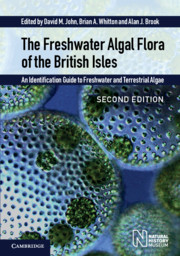 The Freshwater Algal Flora of the British Isles
The Freshwater Algal Flora of the British Isles Book contents
- Frontmatter
- Contents
- The online material (formerly provided in DVD format)
- List of Contributors
- Foreword
- Preface
- Acknowledgements
- Introduction
- Distribution and Ecology
- History of Freshwater Algal Studies in the British Isles
- Field Methods
- Laboratory Methods
- Water Framework Directive
- Cultures of British Freshwater Algae
- Classification
- Key to phyla
- Cyanobacteria (Cyanophyta)
- Phylum Rhodophyta (Red Algae)
- Phylum Euglenophyta (Euglenoids)
- Phylum Cryptophyta (Cryptomonads)
- Phylum Dinophyta (Dinoflagellates)
- Phylum Raphidophyta
- Phylum Haptophyta (Prymnesiophyta)
- Phylum Chrysophyta (Golden Algae)
- Phylum Xanthophyta (Tribophyta) (Yellow-Green Algae)
- Phylum Eustigmatophyta
- Phylum Bacillariophyta (Diatoms)
- Phylum Phaeophyta (Brown Algae)
- Primitive Green Algae (‘PRASINOPHYTA’)
- Phylum Chlorophyta (Green Algae)
- Phylum Glaucophyta
- Glossary
- Standard Form of Authors of Algal Names
- Sources of Illustrations or Material
- References
- Taxonomic Index
- Subject Index
- Plate Saction
- Miscellaneous Endmatter
- Miscellaneous Endmatter
Cultures of British Freshwater Algae
Published online by Cambridge University Press: 12 January 2024
- Frontmatter
- Contents
- The online material (formerly provided in DVD format)
- List of Contributors
- Foreword
- Preface
- Acknowledgements
- Introduction
- Distribution and Ecology
- History of Freshwater Algal Studies in the British Isles
- Field Methods
- Laboratory Methods
- Water Framework Directive
- Cultures of British Freshwater Algae
- Classification
- Key to phyla
- Cyanobacteria (Cyanophyta)
- Phylum Rhodophyta (Red Algae)
- Phylum Euglenophyta (Euglenoids)
- Phylum Cryptophyta (Cryptomonads)
- Phylum Dinophyta (Dinoflagellates)
- Phylum Raphidophyta
- Phylum Haptophyta (Prymnesiophyta)
- Phylum Chrysophyta (Golden Algae)
- Phylum Xanthophyta (Tribophyta) (Yellow-Green Algae)
- Phylum Eustigmatophyta
- Phylum Bacillariophyta (Diatoms)
- Phylum Phaeophyta (Brown Algae)
- Primitive Green Algae (‘PRASINOPHYTA’)
- Phylum Chlorophyta (Green Algae)
- Phylum Glaucophyta
- Glossary
- Standard Form of Authors of Algal Names
- Sources of Illustrations or Material
- References
- Taxonomic Index
- Subject Index
- Plate Saction
- Miscellaneous Endmatter
- Miscellaneous Endmatter
Summary
Stimulated by curiosity about the natural diversity of his environment, collecting, describing and identifying examples of different types of organisms has been the pursuit of scientists and amateur collectors for centuries. In the case of microalgae, these studies rapidly advanced in the late nineteenth and early twentieth centuries, coinciding with developments in microscopy. This subsequently led to the publication of comprehensive algal guides such as West and Fritsch’s A Treatise on the British Freshwater Algae (1927). In most cases field material was examined, and field samples remain the starting point for the description and identification of new taxa. However, although the study of field material is of paramount importance for many taxonomic, biodiversity and ecological studies, there are limitations to the scientific, and for that matter biotechnological, exploitability of these samples. Algal cultures provide workers with defined, in some cases axenic, reproducible materials. These cultures, when appropriately documented, are, in effect, ‘biological standards’ on which much of the published algal-related science, ecotoxicology and commercial exploitation are built. Furthermore, without defined algal cultures, reproducible, comparative, developmental, physiological, molecular and other studies would be at best problematic to perform.
The first report on laboratory-based algal culturing dates from 1850, when Ferdinand Cohn, one of the founders of bacteriology, maintained a non-clonal, but probably unialgal, culture of Haematococcus pluvialis. Subsequently, workers in Russia successfully maintained green algae in artificial defined mineralbased medium (Famintzin, 1871), with the first clonal, axenic cultures maintained on defined medium being attributed to Beijerinck in the 1890s (see Preisig and Andersen, 2005). At least one Beijerinck culture from this time, Chlorella vulgaris CCAP 211/11B, which is employed in ecotoxicology (OECD, 1984), has been continuously maintained by serial transfer since 1892. Furthermore, the use of clonal cultures has subsequently become the standard approach for most laboratory studies.
Algal cultures are routinely serial subcultured using aseptic microbiological techniques. In most cases this involves transferring an inoculum from a late log or early stationary phase culture into fresh, presterilized medium. The objective is to retain a healthy, physiologically, morphologically and genetically representative specimen that can be used at short notice. A key factor to be considered is that different ages of subcultures may provide different stages of the life cycle (e.g. aplanospores in addition to green dividing and motile cells in early stationary phase cultures of Haematococcus pluvialis).
- Type
- Chapter
- Information
- The Freshwater Algal Flora of the British IslesAn Identification Guide to Freshwater and Terrestrial Algae, pp. 25 - 26Publisher: Cambridge University PressPrint publication year: 2021
